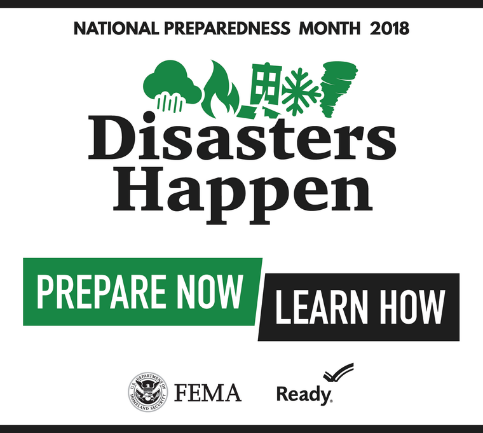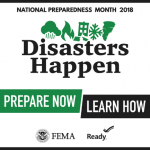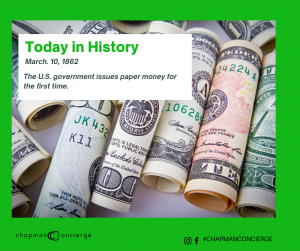National Preparedness Month 2018: Prepare Now Learn How
National Preparedness Month
National Preparedness Month (NPM), recognized each September, provides an opportunity to remind us that we all must prepare ourselves and our families now and throughout the year. This NPM will focus on planning, with an overarching theme: Disasters Happen. Take time to learn lifesaving skills − such as CPR and first aid, check your insurance policies and coverage for the hazards you may face, such as flood, earthquakes, and tornados. Make sure to consider the costs associated with disasters and save for an emergency. Also, know how to take practical safety steps like shutting off water and gas.
The devastating hurricanes and wildfires of 2017 reminded the nation of the importance of preparing for disasters. Often, we will be the first ones in our communities to take action after a disaster strikes and before first responders arrive, so it is important to prepare in advance to help yourself and your community.
Weekly Preparedness Themes
Week 1: Sept 1-8 Make and Practice Your Plan
Week 2: Sept 9-15* Learn Life Saving Skills
Week 3: Sept 16-22 Check Your Insurance Coverage
Week 4: Sept 23-29 Save For an Emergency
September 15 is a National Day of Action
Information shared with permission by Ready.gov. For more information and resources throughout National Preparedness Month visit HERE.
Emergency Notification Systems
There are some systems available to register for which will keep you updated on both local and national events. Here are some links for additional information:
Smart 911 – Create a safety profile that includes information you want 9-1-1 and response teams to have in the event of an emergency.
Nixle – Register to receive alerts from your local agencies.
Preparedness for those with Special Needs – This allows individuals with special needs, their families, and caregivers the ability to provide information to emergency response agencies so emergency responders can better plan to serve them in a disaster or emergency.
Don’t forget, your local Township or Municipality may offer a service that provides alerts, news, and information about happenings in your area. Learn what resources they are now so you can better prepare yourself in case of an emergency.
Preparedness Planning for Children
Emergencies and disasters can happen at any time, often without warning. Disaster planning, response, and recovery efforts must take into account the unique needs of children, who make up roughly a quarter of the U.S. population. These efforts should also engage the unique strengths that children to bring to emergency preparedness. We have gathered resources created by Ready.Gov for you to share with your friends and family. You can find them by visiting HERE.
Every second counts in an emergency situation, which is why it is crucial to have a game plan. There are key steps that you can take to prepare your family for disaster better. Having an emergency kit prepared which includes a designated neighborhood and in town meeting spot, out-of-town contact, work school, family, medical and insurance contact information will allow your family to stay in touch whether you are together or not and be prepared for when disaster strikes. If you have small children, make sure they know both the home number and cell phone number of their parents.
When a big storm is coming, you want to make sure you have enough supplies to last at least 3 days.
- Water-at least 1 gallon per day per person
- First aid kit
- Fire extinguisher
- Flashlights and batteries
- Cell phone with charger
- Important family documents
- Perishable food available
- Pet supplies
- Infant formula & diapers
- Your child’s favorite toys/games & favorite stuffed animal or security blanket
- Fill your car with gas
- Fill plastic bags with water and place them in the freezer
- Get extra cash out of the bank
- Prescriptions


 in
in  by
by  August 24, 2018 at 1:38 pm
August 24, 2018 at 1:38 pm






Comments are closed.